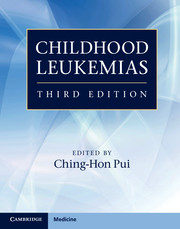Book contents
- Frontmatter
- Contents
- List of contributors
- Preface
- Section 1 History and general issues
- 1 History of leukemia: historical perspectives
- 2 Diagnosis and classification
- 3 Epidemiology and etiology
- Section 2 Cell biology and pathobiology
- Section 3 Evaluation and treatment
- Section 4 Complications and supportive care
- Index
- Plate Section
- References
3 - Epidemiology and etiology
from Section 1 - History and general issues
Published online by Cambridge University Press: 05 April 2013
- Frontmatter
- Contents
- List of contributors
- Preface
- Section 1 History and general issues
- 1 History of leukemia: historical perspectives
- 2 Diagnosis and classification
- 3 Epidemiology and etiology
- Section 2 Cell biology and pathobiology
- Section 3 Evaluation and treatment
- Section 4 Complications and supportive care
- Index
- Plate Section
- References
Summary
Introduction
The acute leukemias of childhood are a heterogeneous group of diseases. In this review of the descriptive and analytic epidemiology of these malignancies, specific subgroups are emphasized, as defined by morphology, cytogenetic features, or molecular markers. There is evidence that specific leukemic subgroups may have distinct etiologies, and that molecular abnormalities associated with particular subgroups may be linked with specific causal mechanisms. Moreover, the mutations produced at the successive stages of leukemogenesis, from initiation through induction to promotion, may all involve separate etiologic processes.
It is also important to note that changes over time in diagnostic practice and precision may account in part for some reported epidemiologic trends. Moreover, changes in terminology and classification schemes for leukemia make it difficult to make direct comparisons between studies, particularly if risk factors differ for different subgroups. However, in assessing risk factors, studies of the childhood leukemias present several methodologic advantages. The interval between exposure to putative risk factors and onset of leukemia may be shorter, recall of exposures is likely to be better, and intervening factors may be fewer than those associated with adult leukemias. These characteristics of childhood leukemia may facilitate identification of the most likely risk factors for the various leukemic subgroups. Furthermore, they lend themselves to an approach that includes both population studies and molecular epidemiologic techniques, permitting the design of research to assess genetic–environmental causal interactions. As studies of potential environmental causes of childhood leukemia have now accumulated to a degree that allows data synthesis, and in order to succinctly summarize the literature, recent meta-analyses rather than individual studies are cited preferentially below.
- Type
- Chapter
- Information
- Childhood Leukemias , pp. 49 - 71Publisher: Cambridge University PressPrint publication year: 2012
References
- 3
- Cited by



